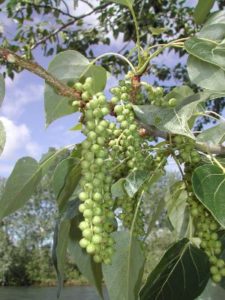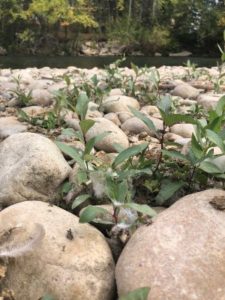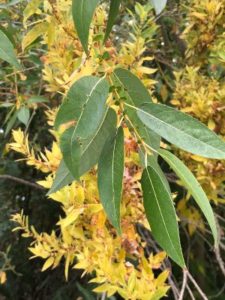by Rob Tiedemann, Ph.D.
Humans – by nature – are curious, fleet-footed, and tend to wander. While for now, we have agreed to curb our wander lust – as advised by the Center for Disease Control – we can still imagine repeated strolls along the Lower Boise River where the scenery is forever changing (see safe recreation guidelines below). Flora growing along the floodplain is a big part of that change (see Figure 1). Here‘s a guide to the blooms you would see over time if you went for repeated walks along the Greenbelt.

Yellow Signals the Arrival of Spring
Yellow blooms of the shrub, golden currant (Ribes aureum) (see Figure 2) are the first flowers of spring along the Lower Boise River floodplain. They grow in early April as clusters on the tips of smooth branches with papery leaves. The tiny green fruits that appear in late fall are part of a food fest for wildlife throughout winter.



Oregon grape (Mahonia repens) (see Figure 3) is the next shrub to bloom. Also with yellow flowers, but with gnarly branches and leathery leaves. Its purple fruits grow in tight clusters and persist well into the winter season.
Later in spring, shattered pods from the prominent tree black cottonwood (Populus trichocarpa) (see Figure 4) will be lying on the ground where they appear as soft sided, long, slender shells that are yellow/brown in color. Look up to see the male catkins that they covered earlier in the season. Those catkins are now drooping from branches and shedding pollen.
White Blooms Beckon Summer



By late April, you will see white blooms (See Figure 5) of Saskatoon serviceberry (Amelanchier alnifolia) on slender grey branches arching upward from a common base on the ground, looking like they have been intentionally gathered and arranged by a florist in a vase. Soon after, clusters of creamy white blooms on the vivid red stems (see Figure 6) of red-osier dogwood (Cornus stolonifera a.k.a. sericea) will dot the landscape.
Tiny Seeds Grow Into Huge Trees
And in June, there will appear a second round of white/yellow/brown pods, strewn across the floodplain floor, preceding the release of an abundance of black cottonwood seed. The tiny seeds rest inside a catkin that, when the fruits are ripe, look like tiny clusters of grapes (see Figure 7). When fully mature they appear as a cocoon of white tufts of hair that allow seed to hang in the air and drift for great distances (see Figure 8). It wanders hoping to find bare, moist soil to germinate and grow as an independent tree, fledged from its parents (see Figure 9).



Do not mistake a tree of this kind (see Figure 10) from others like it that have grown, not from seed but, as clones tethered to their parents. These duplicates often appear on the ground in a single-file line of stems growing from their parent, with leaves larger than seedlings of similar height. As adults, they will likely lack the stature and robust canopy of their relatives that grew from seed. Most importantly, because they are clones they do not contribute to the genetic diversity of the population of black cottonwood trees growing along the river, making the forest less fit to adapt to changes in the environment.



Summer Flowers Bear Fruit
Later in the season, by mid-summer, the pink flowers of Wood’s rose (Rosa woodsii) (see Figure 11) will appear along their red stems that are armored with tiny thorns. By winter those blooms will have borne fruit in the form of rose hips that are an important food for birds and other wildlife.
A familiar painter’s palette of color will appear across the floodplain in fall. Look for the uniform pastel yellow on the leaves of river birch (Betula occidentalis) and Pacific willow (Salix lasiandra) (see Figure 12) and the conspicuous red, orange, and yellow on the tiny leaves of Douglas hawthorn (Crataegus douglasii).
Winter Colors
While the scenery may be subdued, there is still much to see in winter. With the curtain of leaves drawn to the ground, look for the subtle variety of colors and textures along the stems of shrubs and trees. Match the botanical descriptions of texture and pattern – like smooth, furrowed, ridged, and mottled (see Figure 13) – with what you see. And, wait just a short time for spring when this seasonal pattern will repeat itself for you to enjoy again.
Share your observations with BREN via email, info@boiseriverenhancement.org. Include photos and locations if you’d like. Citizen science is an important part of the work of the Boise River Enhancement Network. Please know, we appreciate the work you do for the common good.
For more go to the US Department of Agriculture Plants Database.
All Photo Credits: Rob Tiedemann, Ph.D. ©
